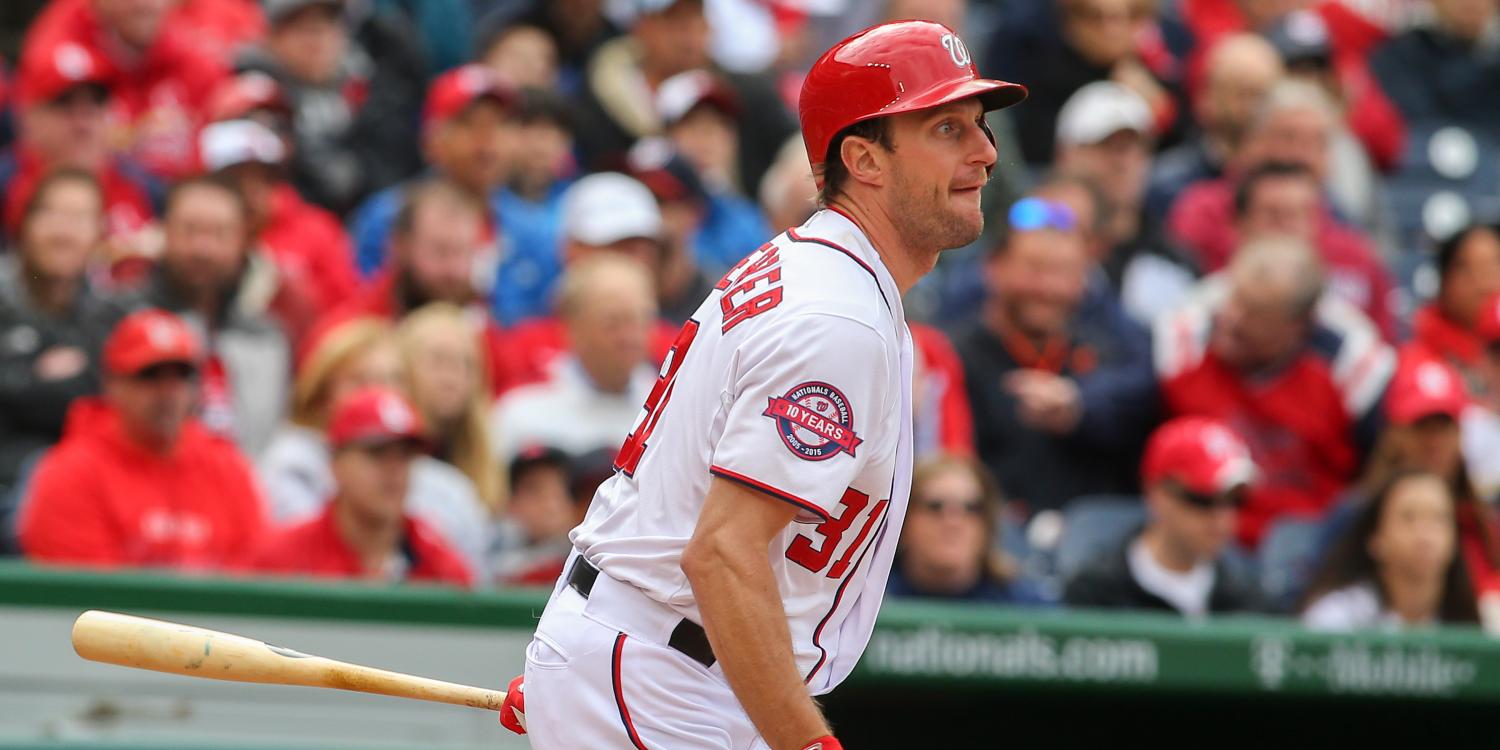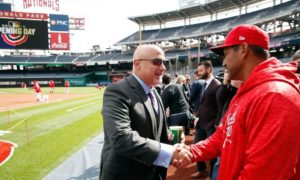Max Scherzer’s Weird Streak

Some players are just so good at everything, it’s almost unfair. Max Scherzer has won the last two NL Cy Young awards. His stat page has more black ink than a legal disclaimer. By any measure, he’s among the best pitchers in baseball, and probably at the very top. When you’re already the best pitcher, there’s only one way to improve: hit .300.
Scherzer is 15-50 at the plate this season, which is an even .300 batting average. That includes 14 singles and a double, but he’s also walked once, been hit by a pitch twice, and even stolen a base! It’s by far the best offensive output of his career. Even more impressive is his current six-game hitting streak.
Pitcher Hitting Streaks
For a position player, a six-game hitting streak is nice, but nothing really special. For a pitcher, it’s cause for celebration. There are several factors that make it especially difficult for pitchers to string together hitting streaks.
- Talent. This isn’t exactly a hot take, but pitchers suck at hitting. MLB pitchers have combined for a .113/.144/.145 slash line in 2018. With a much lower true talent level than actual professional hitters, the odds of a base hit in any given plate appearance are much lower.
- Rest. Like most other starting pitchers, Scherzer usually comes to bat just one out of every five days (longer if he pitches in an AL ballpark). A position player on a six-game hitting streak has had a pretty good week. Scherzer’s streak stretches all the way back to July 7.
- Practice. Sure, pitchers take swings in the batting cage. But the amount of time and focus they spend on hitting is minuscule compared to their devotion to pitching.
- Opportunity. If a starting pitcher lasts five innings, he probably only bats once or twice. Even then, there’s a chance the manager will force him to sacrifice the runner over, taking away even more chances to swing the bat. That leaves very little margin for error to sustain a hitting streak. Scherzer does have an advantage over other pitchers. As stated, he’s arguably the world’s greatest pitcher, which means he stays in the game longer. He’s come to the plate 17 times during the streak because he’s averaged nearly seven innings per start.
All of these factors are relatively new obstacles for modern pitchers, except for possibly #3. In years gone by, pitchers were much better hitters than they are now. 20 years ago, they batted .146/.187/.183. 60 years ago, it was .165/.210/.211. They also pitched on shorter rest and lasted longer in games.
As a result, 38 of the 40 longest pitcher hitting streaks came before 1973- the first year of the designated hitter. This includes Wilbur Cooper‘s record 16-game streak in 1924. The post-DH record is 13 games by Carlos Zambrano in 2008. Rick Rhoden had an 11-game streak in 1984, but other than these two slugging hurlers, no one else has topped eight games in more than 50 years.
Scherzer’s Streak
Clearly, Scherzer’s streak is pretty special. With his bat heating up over the last few weeks (or games, it’s really the same thing for a pitcher), he’s now batting an even .200 for his career. That’s not very good for a real batter, but it’s fantastic for a pitcher. (In fact, he had another six-game hitting streak back in 2015!)
Assuming .200 is his true talent batting average, he should get a hit once every five at bats. During the streak, he’s 6-12, and he’s also sacrificed four times and been hit by a pitch. By true talent, he should’ve had only two or three hits during that time.
How long can this continue? Well, Scherzer averages 2.38 at bats per start this year (not counting his two relief appearances). Obviously, he would need to get a hit in at least one of those in each game to perpetuate the streak. A true talent .200 hitter has a 41.2% chance of getting a hit when given 2.38 at bats. Now that we know this, the chances of Scherzer reaching a six-game streak are just 0.49%. He’s done it twice! That’s kind of incredible!
However, the streak is still ongoing. To match Zambrano’s modern record of 13 games, Scherzer has just a 0.001% chance. Not impossible, but pretty close. He has a 0.0007% shot at tying Cooper’s all-time record by a pitcher. Of course, the longest MLB hitting streak ever was Joe DiMaggio‘s famous 56-game streak in 1941. Scherzer only has 50 more games to go! His chance of catching Joltin’ Joe is 0.00000000000000000003%.
Awards
Far more realistic, but only slightly more meaningful, is how Scherzer’s offense can help him fill his trophy case. There are four major awards for which he’s eligible:
- MVP
- Cy Young
- Gold Glove
- Silver Slugger
He stands a decent chance of winning his third consecutive CY, but no level of hitting prowess will help him get there. It also won’t win him a Gold Glove. That leaves MVP and Silver Slugger.
MVP
Pitchers don’t win MVP awards very often. That being said, perhaps 2018 is just the right kind of year for that to happen. WAR may or may not be the best way to determine the MVP; that’s a debate for another day. It certainly doesn’t hurt that Scherzer’s 7.2 bWAR leads the NL, including position players. Here are the current NL bWAR leaders:
| Player | bWAR |
| Max Scherzer | 7.2 |
| Aaron Nola | 6.8 |
| Jacob deGrom | 6.7 |
| Lorenzo Cain | 5.4 |
| Kyle Freeland | 5.3 |
| Matt Carpenter | 5.1 |
Four out of the top five are pitchers, as are the three far-and-away front-runners. For pitchers, most of the bWAR total comes from their primary job, but offense factors in as well. Here’s the top three pitchers broken down by pitching and offense:
| Player | Pitching WAR | Offense WAR | Total |
| Max Scherzer | 6.5 | 0.7 | 7.2 |
| Aaron Nola | 6.9 | -0.2 | 6.8 |
| Jacob deGrom | 6.5 | 0.2 | 6.7 |
Without his superior bat, Scherzer is no longer the best player in the NL! Aaron Nola would become the favorite to be the WAR leader, and thereby the most likely pitcher to win the MVP. Of course, MVP voting is much more complicated than that, while also frequently making no sense at all. Nevertheless, Scherzer’s offense could play a big role in his MVP quest- even if the voters don’t realize it!
Silver Slugger
This should be much more cut-and-dry, at least in theory. The Silver Slugger goes to the best hitter at each position, including pitcher in the NL. Scherzer’s .300 batting average is second in the league behind German Marquez‘ .350, and he leads the league with 57 plate appearance.
Using a more advanced approach, his 83 wRC+ is fourth in the league, but the leaderboard shows us that it’s not really close:
| Player | wRC+ | PA |
| Michael Lorenzen | 204 | 17 |
| German Marquez | 95 | 42 |
| Brent Suter | 85 | 32 |
| Max Scherzer | 83 | 57 |
ARE YOU KIDDING, MICHAEL LORENZEN?!? The Reds’ reliever clobbered three home runs in just 17 trips to the plate! In theory, this gives him a huge lead, but each of the three main contestants has a significant disadvantage:
- Lorenzen: No reliever has ever won the Silver Slugger. There’s no minimum threshold for plate appearances, but all previous winners have come to bat at least 50 times. For comparison, Tyler Glasnow had a .455 OBP in 2017, but failed to win the award because he only collected 23 plate appearances. Lack of plate appearances could also spell trouble for Suter.
- Scherzer: In spite of his high batting average and hitting streak, Scherzer hasn’t yet hit a home run this season. Since 2001, the only Silver Slugger winners without a long ball are Adam Wainwright (2017) and Zack Greinke (2013).
- Marquez: Does the Coors Field bias extend to hitting pitchers? Marquez is probably the best overall candidate right now, but will voters overpenalize him for playing in Colorado? No Rockies pitcher has won since Mike Hampton in 2001-02. I don’t know. This is a weird award.
Scherzer will probably make his next start this weekend against the Cubs. Maybe he’ll extend his hitting streak, and maybe he won’t. Perhaps he’ll even smack a home run! Regardless, the Nationals pay him for his arm and not his bat, but they certainly don’t mind the bonus his offense provides.
-Daniel R. Epstein


















